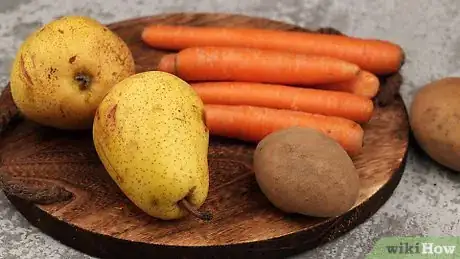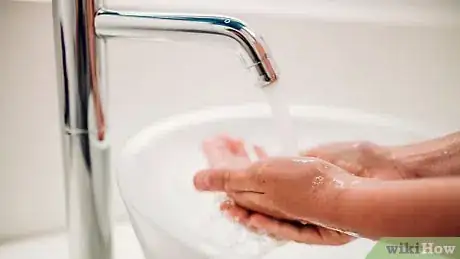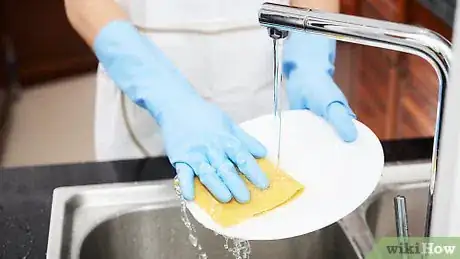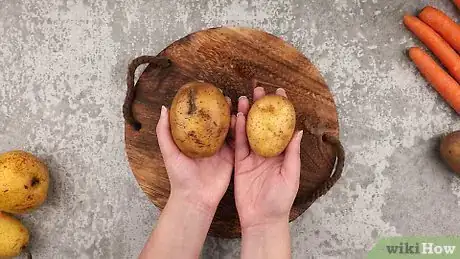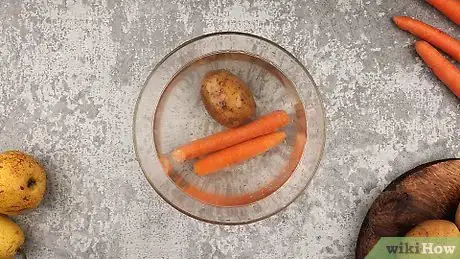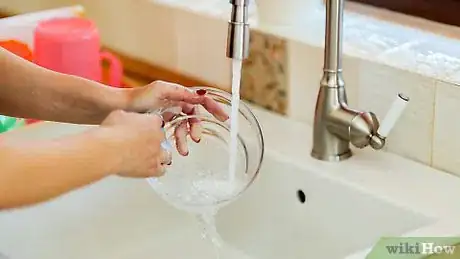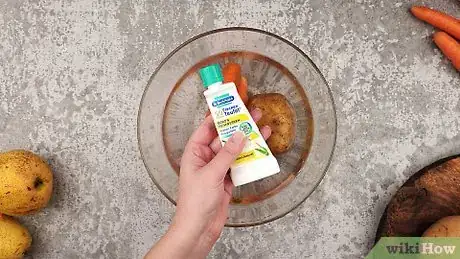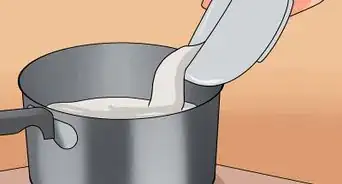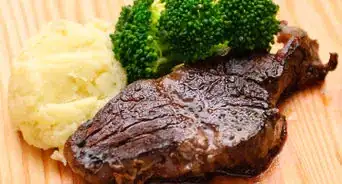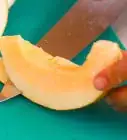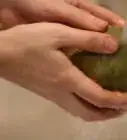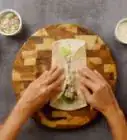This article was co-authored by Randall Chambers. Randall (Randy) Chambers is a Personal Chef and the Owner of Luxury Meals From Home based in Arvada, Colorado. He has more than 16 years of commercial kitchen experience, five years of sous chef experience, and two years of experience as an executive chef. Chef Randy draws inspiration from his half Bolivian background and his forte is South American cuisine. He holds an Associate’s degree in Culinary Arts from The Art Institute.
There are 7 references cited in this article, which can be found at the bottom of the page.
wikiHow marks an article as reader-approved once it receives enough positive feedback. This article received 15 testimonials and 100% of readers who voted found it helpful, earning it our reader-approved status.
This article has been viewed 542,391 times.
Eating a variety of fresh fruits and vegetables is key to maintaining a healthy diet and overall lifestyle. However, the increasing number of food-borne outbreaks related to produce and growing concern about the use of pesticides on produce have made food safety an important issue in recent years. Washing your fruits and vegetables remains one of the best ways to protect yourself and your family from illnesses and chemical contamination. Here are a number of ways in which you can effectively wash and handle your fruits and vegetables prior to cooking them.
Steps
Rinsing Produce with Water
-
1Prepare produce for washing. Remove fruits and vegetables from any packaging.
- The water rinse method is effective for all fruits and vegetables. However, some types of vegetables, including broccoli, lettuce leaves, or spinach, often require additional attention and cleaning.
- If you have packaged produce labeled "ready-to-eat,” “washed” or “triple washed,” do not re-wash.[1]
- For fruits and vegetables that have a skin, the Food and Drug Administration recommends that you wash them BEFORE you peel them.[2]
- Remove stickers from produce. It most likely won't harm you to eat the sticker; however, this is not recommended[3] and it is best to remove them before washing. Otherwise, the part underneath the sticker will not be cleaned.
-
2Wash your hands. Use warm, soapy water to make sure that your hands are clean before handling any fresh produce. Wash for at least 20 seconds.[4]Advertisement
-
3Cut away any damaged or bruised areas of your produce.[5] Bruises and cuts can allow pathogens to enter the fruit or vegetable.
-
4Clean your countertop, cutting boards, and utensils. After you prepare each food item, wash kitchen surfaces and utensils with hot, soapy water.
- Keeping your workspace clean is especially important if you have peeled your produce without washing it. Bacteria from the outside of raw produce can be transferred to the inside when it is cut or peeled.[6]
-
5Rinse produce with cool or cold water.[7] You'll want to make sure the water is potable, meaning safe to drink.[8]
- You can use warm water, but it's best used if you're planning to cook the fruits and vegetables after washing.
- Place a colander in the sink to expedite the process of rinsing your produce. Because you can wash more than one thing at once, a colander is especially useful if you are cleaning fruit and vegetables that are loose, such as beans or fresh peas.
- Just a little rinsing is fine—you don't need to overdo it.[9]
-
6Be gentle with fragile produce. Some fruits and vegetables, like raspberries, which crush easily and become mushy when they take in too much water, should not washed vigorously. Instead, put delicate produce in a colander and gently spray with water.[10]
- Mushrooms need to be cleaned differently than other vegetables. If you rinse them too much or soak them water, they will become soggy. If you must rinse them, do it lightly, with just a sprinkle of water. Dry immediately and gently with paper towels. The best way to clean mushrooms is wipe them with a clean, just damp cloth or paper towel.
-
7Scrub any produce with a thick skin. Use a vegetable brush to scrub produce such as potatoes and carrots, which are grown in soil, or cucumbers and melons. Brushing them helps to wash away hard-to-remove microbes; just make sure the brush isn't too rough or it could damage the produce.[11]
-
8Inspect your produce. Make sure there are no specs of dirt or any tiny bugs remaining on your fruit and vegetables. If you find some, re-wash the produce.
-
9Dry produce after washing. Dry everything you have rinsed with a clean paper towel. This will remove any lingering bacteria.[12]
Soaking Produce
-
1Fill your sink with cool, potable water. You can also use a bucket or other container if you don't want to fill your sink.
- Use this method for fruits and vegetables with a lot of surface area (such as grapes), that are attached or packed tightly (like strawberries or blueberries) or have deep crevices (cauliflower, broccoli, and leafy greens).
-
2Dip your fruits and vegetables into the water and swirl or swish them around. Make sure there is a bit of movement here so that the outside of the produce can be thoroughly cleaned.
- This method is effective for grapes and other foods which have a lot of surface area and are tightly packed. Because they are immersed in water, the water can cover their entire outer surface, something that is considerably harder to do with just a rinse.
-
3Soak produce with a lot of nooks and crannies for 1-2 minutes. Vegetables like cauliflower, broccoli, and leafy greens need extra attention because they have lots of places where dirt and microbes can hide.[13]
- Leafy greens have their own particular method for cleaning. First, separate the leaves first. Then, soak the leaves and drain them in a strainer or colander. Repeat this process. The goal here is dilution. Once finished, dry with a clean towel or salad spinner.[14]
- Soaking all kinds of fruits and vegetables - not just your greens, but fruits like strawberries too - has recently become popular. Soaking is a restorative process that can revive your produce, enhance its taste and prolong its life.[15]
-
4Clean everything after each use. Use warm, soapy water to wash your colander, salad spinner or basin when ready to move on to another fruit or vegetable.
Using Other Solutions
-
1Use distilled water to rinse and/or soak produce of all varieties. Distilled or bottled water has been filtered and purified to remove contaminants.[16]
- You can also used very clean cold tap water to clean produce instead of distilled water.
-
2Use a saltwater solution. Soak fruits and vegetables of all varieties in water for 5 minutes with 1-2 teaspoons of salt. Then, rinse to wash out the salt.
-
3Use a water-and-vinegar solution to soak produce of all varieties. Soak produce in a mixture of water and vinegar (1/2 cup distilled white vinegar per 2 cups of water) for 5-15 minutes. Then, rinse.
- This has been shown to move pesticides and reduce - though not eliminate - bacteria. This solution may, however, affect texture and taste.[17]
-
4Use a "fruit and veggie" commercial wash. These washes, basically rinses and other treatments, are now sold in grocery and health food stores.
- Some brands include: Dr. Mercola's Fruit and Vegetable Wash, Fit Organic Fruit and Vegetable Wash, Ozone Water Purifier XT-301, J0-4 Multi-Functional Food Sterilizer (Indoor Purification Systems, Layton, UT).
- Researchers at the University of Maine tested some of these products against a basic water wash and found no significant differences between a "fruit veggie wash" and a water wash. In fact, in some of their tests, the water wash was more effective in cleaning fruit from outside substances than the commercial washes.[18]
Warnings
- Avoid using hot water when washing produce. Hot water will cause vegetables and fruit to shrivel, bruise or scald.⧼thumbs_response⧽
- The Food and Drug Administration does not recommend using soap or other detergents to wash produce.⧼thumbs_response⧽
References
- ↑ http://www.fda.gov/Food/FoodborneIllnessContaminants/BuyStoreServeSafeFood/ucm114299.htm#prep
- ↑ http://www.fda.gov/Food/FoodborneIllnessContaminants/BuyStoreServeSafeFood/ucm114299.htm#prep
- ↑ https://www.snopes.com/fact-check/fruit-stickers-edible/
- ↑ http://www.fda.gov/Food/FoodborneIllnessContaminants/BuyStoreServeSafeFood/ucm114299.htm#prep
- ↑ http://www.bhg.com/recipes/how-to/cooking-basics/how-to-wash-fruits-and-vegetables/
- ↑ http://umaine.edu/publications/4336e/
- ↑ Randall Chambers. Personal Chef. Expert Interview. 1 March 2022.
- ↑ http://umaine.edu/publications/4336e/
- ↑ Randall Chambers. Personal Chef. Expert Interview. 1 March 2022.
- ↑ http://umaine.edu/publications/4336e/
- ↑ http://www.fda.gov/Food/FoodborneIllnessContaminants/BuyStoreServeSafeFood/ucm114299.htm#prep
- ↑ http://www.fda.gov/Food/FoodborneIllnessContaminants/BuyStoreServeSafeFood/ucm114299.htm#prep
- ↑ http://umaine.edu/publications/4336e/
- ↑ http://umaine.edu/publications/4336e/
- ↑ http://www.telegraph.co.uk/foodanddrink/9365571/The-benefits-of-bathing-your-vegetables.html
- ↑ ref>http://umaine.edu/publications/4336e/
- ↑ http://umaine.edu/publications/4336e/
- ↑ http://umaine.edu/publications/4336e/
- ↑ http://umaine.edu/publications/4336e/
- ↑ http://www.fda.gov/Food/FoodborneIllnessContaminants/BuyStoreServeSafeFood/ucm114299.htm#prep
- ↑ http://umaine.edu/publications/4336e/
About This Article
"To properly wash fruits and vegetables, remove them from their packaging and peel off any stickers. Then, cut away any bruised or damaged areas of the produce. Even if you’re planning to peel your produce, you should wash it first to ensure you don’t spread any bacteria from the peel. Rinse the produce under cool running water. Alternatively, you can place it into a colander and gently spray the produce with cold water. Dry your fruits or vegetables thoroughly with a clean cloth."
